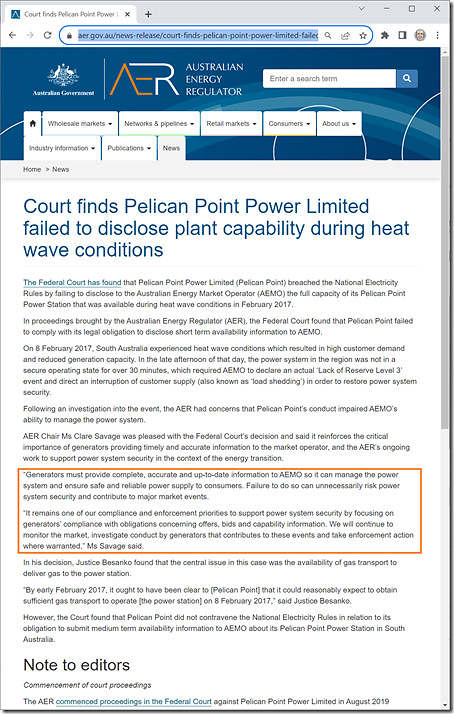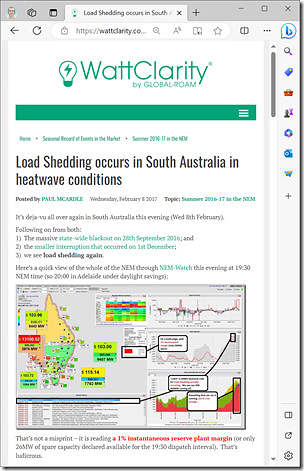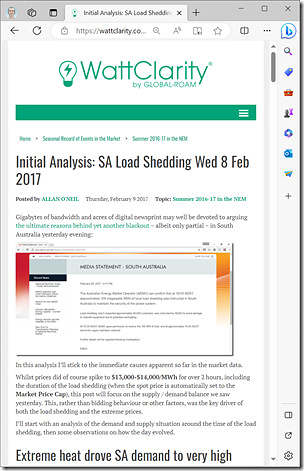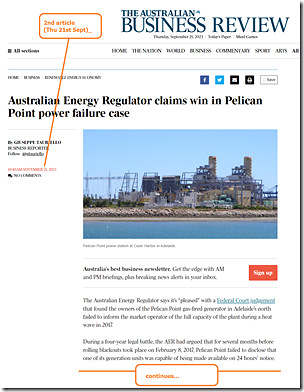Also in the news this week was the Federal Court judgement in the matter of ‘Australian Energy Regulator v Pelican Point Power Ltd [2023] FCA 1110’:
1) This web page provides details of the judgement;
2) With the original Word Document here.
Following the judgement, the AER published this Media Release:
… which links through to more detailed information on the AER page about ‘Pelican Point in court for alleged breaches of National Electricity Rules’ from August 2019.
(A) Quick notes about February 2017
We’ve been posting about market events in the NEM for perhaps 15 years.
So out of interest I flipped through the February 2017 archives on WattClarity and in particular see these two articles about the LOR3 (i.e. Load Shedding) that occurred on that Wednesday 8th February 2017:
| Article on the day:
‘Load Shedding occurs in South Australia in heatwave conditions’ |
Next Day
‘Initial Analysis: SA Load Shedding Wed 8 Feb 2017’ |
|---|---|
|
On the day itself, we wrote about ‘Load Shedding occurs in South Australia in heatwave conditions’:
|
Then the next day, Allan contributed with this ‘Initial Analysis: SA Load Shedding Wed 8 Feb 2017’:
|
(B) Media Coverage
I first learned of this Federal Court ruling in a series of 2 x articles in the Australian by Giuseppe Tauriello here:
| Wed 20th Sept 2023
|
Thursday 21st Sept 2023
‘Australian Energy Regulator claims win in Pelican Point power failure case’ |
|---|---|
|
First was the article ‘Pelican Point owner cleared of market information failures’ on Wednesday 20th September:
|
Then was the article ‘Australian Energy Regulator claims win in Pelican Point power failure case’ on Thursday 21st September: … which references the media release above.
|
(C) Big upcoming changes on Monday 9th October 2023
In the snapshot from the AER Media Release above, I’ve highlighted some words from AER Chair, Clare Savage as follows:
‘“Generators must provide complete, accurate and up-to-date information to AEMO so it can manage the power system and ensure safe and reliable power supply to consumers. Failure to do so can unnecessarily risk power system security and contribute to major market events.
“It remains one of our compliance and enforcement priorities to support power system security by focusing on generators’ compliance with obligations concerning offers, bids and capability information. We will continue to monitor the market, investigate conduct by generators that contributes to these events and take enforcement action where warranted,” Ms Savage said.’
(my emphasis added)
Whilst it was of interest to learn of the court ruling in relation to what happened in February 2017, it was of particular interest to us because of some related changes in the market going live in under 3 weeks … on Monday 9th October 2023:
1) The introduction of a 9th and 10th commodity for the FCAS markets … that of Fast Frequency Response; and also
2) The requirement for generators to provide, and the AEMO to publish, additional data for all Scheduled* units
* alas, not for Semi-Scheduled units yet … despite that lack of similar transparency being singled out as one example of Villain #8 some years ago.
These changes were noted in May 2023 with the ‘AEMO’s MMS 5.2, ez2view v9.7, Semi-Scheduled MaxAvail in the Bid, and a self-forecasting example’ article.
For the changes for the MT PASA DUID Availability data, there are two additional data fields being introduced:
1) Unit Recall Times; and
2) Unit State.
You will need to read through the latest AEMO RSIG for more details (or go back to the AEMC Rule Determination for more), but we have underway an upgrade to ez2view software to provide added clarity of unit capability as a result of these new additions … clients should stay tuned for a Release Note on ez2view v9.8.
(D) Heads up for summer 2023-24
We’ve written before about how the ESOO 2023 provided some hints that the supply-demand balance could be tight this coming summer 2023-24
1) it’s worth noting that the probabilistic modelling that underlies the ESOO (e.g. with the range of possible results for VIC in Figure 98 discussed by Allan here) was completed even before the BOM declared that El Niño and a positive Indian Ocean Dipole (IOD) are underway
2) so perhaps, if the modelling was completed again now, the distribution of those circles might look a bit different given the higher likelihood implied by the BOM declaration for hotter and drier conditions, which might contribute to any or all of:
(a) Higher levels of energy consumption (e.g. for airconditioning load); and/or
(b) More significant impact on capability de-rating for almost all types of supply-side options:
i. Such as discussed in some detail here in February 2020.
ii. And which the AEMO specifically highlighted with respect to Wind Farms in the ESOO 2023.
(c) Along with possible network limitations …
i. For instance, from higher temperature sag reducing transfer limits; but also
ii. The possibility of bushfires under transmission corridors.
… and so on…
3) Back in Allan’s earlier article, he noted:
‘The first obvious result in the AEMO chart is that the largest number of scenarios – corresponding to a probability of 75% – see no supply shortfalls. In other words, the modelled “loss of load probability” (LoLP) for 2023/24 is one in four for Victoria.
As AEMO observes, amongst the 25% of scenarios that do see supply shortfalls, the majority might land somewhere between 1 and 11 hours in duration (at the long end, these are probably scenarios with shortfalls on multiple days arising from heatwaves and extended generator breakdowns) and with shortfall amounts of up to around 500 MW (about 11% of average system demand). Elsewhere AEMO unsurprisingly note that these shortfall scenarios are much more likely if this summer turns out hotter than usual: under one in ten year conditions for summer maximum demand, the LoLP rises from 25% to nearly 75%.
But how might any supply shortfalls that eventuate actually play out for individual customers? Might some unlucky campers be off for 11 hours straight, or might all we Victorians somehow have 10% carved off our supply?’
(my highlighting added)
3) Note that El Nino does not raise the probability all the way from 25% to 75% … so it’s anyone’s guess where it now lands (i.e. in somewhere between 25% and 75%).
Stay tuned for summer…







Be the first to comment on "Federal Court finding relating to Pelican Point CCGT on 8th February 2017 … and upcoming market changes"